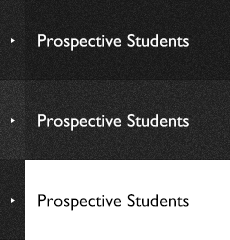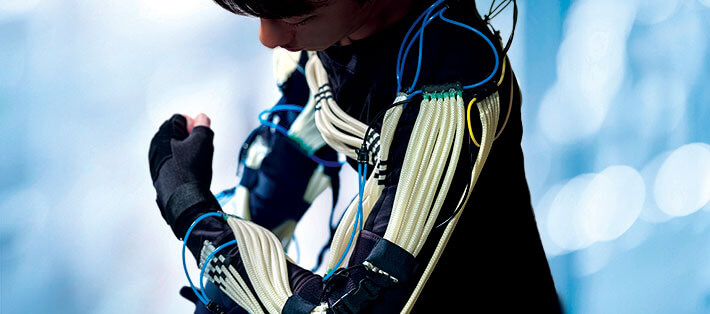
Coming from the humanities to study science at Tokyo Tech, Ko Ishiyama found his calling in creating a new society around artificial intelligence.
Advancing a wide range of fields within robotics, Koichi Suzumori is bringing artificial muscles and other new robots and systems to reality.
With robots and AI continuing to evolve, how will they engage with each other in the future? Will they pave the way for a bright future for humanity?
We asked these two experts to share their thoughts.
(Held on June 7, 2018 at Ookayama Campus)
In moving to the sciences, the path to tomorrow's society became clear
Ishiyama:Thank you for inviting me here today. I haven't been to the campus since I was a grad student. I'm feeling very nostalgic.
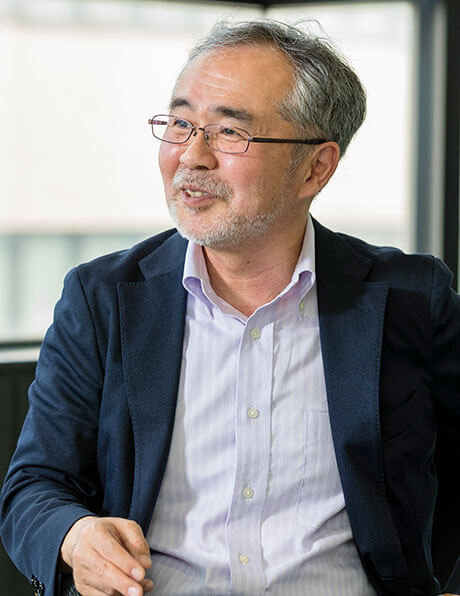
Suzumori:It must have been tough to start a graduate degree in the sciences at Tokyo Tech after doing humanities as an undergrad. You must have had a lot to do.
Ishiyama:I was in my second year as an undergraduate when 9/11 happened. That got me interested in the United States, and I wanted to visit, but had no money. Then one day I happened to come across a programming contest by Carnegie Mellon University, and I knew if I could get accepted, I could go to the States. So I spent every spare moment learning Java. Once over there, I met Professor Hiroshi Deguchi from Tokyo Tech. Deguchi-sensei had two doctorates, in science and economics, and he invited me to join his lab, which is how I ended up transferring to science. However, I needed mathematics to get into Tokyo Tech. So I basically apprenticed myself to a general studies teacher at my university, and went to visit him every evening after classes finished. It was really hard catching up in calculus and linear algebra.
Suzumori:Deguchi-sensei's lab must have been ideally situated for you to move ahead with your own research. What was your topic while you were at Tokyo Tech?
Ishiyama:Mainly on multi-agent simulations. My background was originally in the social sciences, and I was wondering if I couldn't improve social science through computer science. The term "big data" didn't exist back then, and I could only analyze data from agent-based simulations*1. AI involved a lot of research that was shut off from the outside world.
Suzumori:This was just when the internet was coming into its own. Nowadays we can use big data, so in a sense, we can look at society as a whole as a simulator, right?
Ishiyama:You're quite right. In reality, when we create a product and try and find ways to sell it, society's situation and responses change, and we can use the plan-do-check-act cycle as we look at the resultant data. We can expand our research more broadly than when I was a student, and by extension, have greater impact on society.
Suzumori:I'm impressed by how even as a student you already had a vision that led you to where you are now.
Ishiyama:You're too kind. I was researching complex systems in the Department of Computational Intelligence and Systems Science, trying to link micro- and macro-economic phenomena as a model. Nowadays we can collect data on both phenomena and analyze them together.
Suzumori:So what sort of fields do you see your current work being applied in?
Ishiyama:Using AI in long-term elderly care. For example, we can now measure quantitatively how symptoms change among those with dementia when they are looked at, talked to, touched, or give other care. Medicine is backed by scientific data, but long-term care lacks such support. Without data, we had no means to analyze video or images. But now that we can use methods like deep learning, we've been able to use AI to bring a scientific perspective to care-giving. We can now see how social insurance costs and utility functions vary in accordance with changes in symptoms and nursing care level. When I was a student, this was just a theory I wanted to pursue, but now I think it can actually be done.
Suzumori:In science, electrical engineering, electronic engineering, and mechatronics are fields closely related to computer science. From there, we expand out to medicine and the social science of economics, with humanities being the furthest removed. Where do you feel that you are positioned — in the sciences or the arts? Or perhaps the correct answer is that you don't actually discriminate between them.
Ishiyama:Yes, indeed. I started off linking computer science and economics, and now my days are busy with trying to link my knowledge with medicine and nursing care. I feel that if you want to have social impact, it is increasingly necessary to study for a double or triple degree without regard for whether it is in the sciences or arts. Also, in training people in the field of AI, I would like it if universities could provide chances for students to study in steps, starting with fields closely connected with AI such as computer science, machine learning, and robotics.
The concept of "E-kagen" brings a new richness
Suzumori:Actual society still lacks a system that connects the sciences and the arts. I think we need more interdisciplinary fusion among different fields. For example, even if we just look at intelligent robots, we have today's industrial world, where the fields of intelligence (information science) and robots (mechanics) are clearly separated. Even though normally they should be integrated more, the reality is that the engineers in each field work completely separately.
Ishiyama:On the AI side, there is a strong demand for fusion with robotics. However, I think we need another axis based on the purpose of this fusion. For example, adding "long-term care" to "Robots × AI" gives us a clear and specific goal, and I think designing with this sort of directionality is important.
Suzumori:My research is also from a mechanics (robotics) perspective. Sorting robots in factories these days, for example, manage highly precise movements and sophistication in conjunction with AI and deep learning. We can't easily integrate today's robots into our daily lives without problems. That said, robots are precise, accurate assemblies of software and mechanisms, so are very good at moving fast and precisely. But they completely fall apart if called on to do anything outside their programming. In addition, progress in mechanical development is slower than in AI.
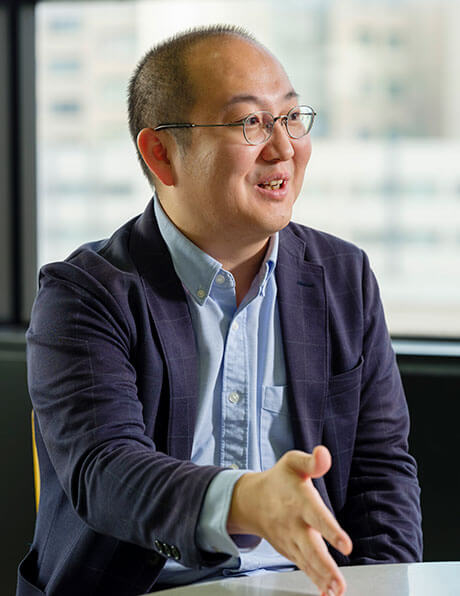
Ishiyama:Yes, there's a bit of a gap between the current state and the image of rapidly evolving robots that we see in the media.
Suzumori:Indeed. I also feel that the direction itself, rather than the speed, of evolution is changing. Since history began, technology has aimed for the power, speed, precision, and accuracy needed for survival against enemies. This only accelerated in the Industrial Revolution and Watt's steam engine. For example, in materials science, the bulk of the research was on stable, strong materials, but there's been a recent change to what you might call unstable materials, such as plastics that decay and return to the soil after a time. In other words, our values have changed from what they were.
Ishiyama:Society has matured, and people are living longer. So that's why we are now looking inside, rather than outside. In long-term care, too, science has started to look at how we can communicate to increase utility functions and indicators themselves. We might say our intentions are to find human richness, or well-being.
Suzumori:With how these times are changing, one of the goals robotics is aiming for is organisms. This doesn't mean simply imitating the appearance of organisms. It's about learning the true essence. Lately, I've been talking about what I call "E-kagen robots," making presentations at international symposiums and publishing in academic journals. The word "E-kagen" [iikagen in romanized Japanese] is an interesting term, which can imply either "good enough" or "irresponsible."
Ishiyama:The same with tekitou [which can mean either "adequate" or "arbitrary"]. What are your views?
Suzumori:It's because up until now irresponsibility has never been permitted in science and technology; it's because we've sought precision and accuracy that we've been able to create such wonderfully accurate, precise robots. But when our target is humans, living creatures, we don't need to worry about movements on the one-micron scale. While robots might be good at that, they're extremely bad at gentle touch, stroking. But that's why we can get away with "good enough" and not build them to be so amazingly accurate. In one sense, the way the responses can differ through various AI learning states is a sort of "irresponsibility." And as they learn, they become "good enough." When writing papers on this idea, I asked people from different countries what the English translation should be. But no one has been able to provide an appropriate phrase. So I want to popularize this uniquely Japanese concept, which has both positive and negative connotations.
Ishiyama:That's so interesting! Certainly, a computer science approach is E-kagen if seen from the backpropagation*2 method used in machine learning. Slow, gradual evolution allows it to be recorded as technology. In today's era of big data, I think even minor evolutions in algorithms will have major social impact.
A fusion of "muscles" that move like human flesh and intelligence that learns from humans
Suzumori:Changing values have social effects, and the possibilities of robotics also greatly expand. In this sense, we are seeing a global boom in soft robotics*3.
Ishiyama:Just now, you talked about living organisms being one of the final goals. What technologies in particular are you working on now?
Suzumori:A human leg, for example, has six degrees of freedom: three in the hip, one in the knee, and two in the ankle. "Degrees of freedom" refers to the number of different directions a joint can freely move. To move in these six degrees of freedom, humans use some fifty different muscles. If we directly apply this to robots, we would need to use fifty motors to move only six things. Naturally, without constraint conditions*4, it would be hard to precisely coordinate all fifty motors. To achieve smooth movement, I am working on actuators*5 which combine the functions of muscles and motors. And that is where softness and E-kagen, which were taboo for industrial robots, become necessary.
![A skeletal robot that moves flexibly using artificial muscles. Professor Suzumori explains: "In a normal robot, for example, we would put a shaft in the knee joint, which fixes its center of rotation in place. But in a human, the axis shifts, and we can use these artificial muscles to recreate this shift, giving us 'E-kagen' movement. Also, the artificial muscles are bunched together. So if we have an air leak, we don't replace that muscle. We tie it off and leave it. This is just like how human muscles atrophy [laughs]."](/english/public-relations/img/110-suzumori-lab-03.jpg)
Photo 1. A skeletal robot that moves flexibly using artificial muscles. Professor Suzumori explains: "In a normal robot, for example, we would put a shaft in the knee joint, which fixes its center of rotation in place. But in a human, the axis shifts, and we can use these artificial muscles to recreate this shift, giving us 'E-kagen' movement. Also, the artificial muscles are bunched together. So if we have an air leak, we don't replace that muscle. We tie it off and leave it. This is just like how human muscles atrophy [laughs]."
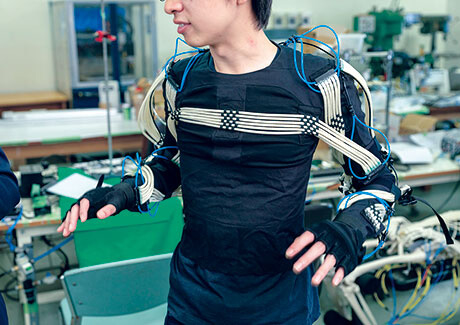
Photo 2. Tomoki Abe (2nd year master's student, Mechanical Engineering, School of Engineering), who appears on the cover, is wearing a special power suit created by a full-body 3D scan. Injecting air into artificial muscles raises his arm, even though his own muscles are relaxed. The initial goal is to provide support in tasks requiring extended periods of arm-raising, such as in manufacturing and agriculture, with the eventual goal of finding use in care and welfare.
Ishiyama:Controlling industrial robots is definitely difficult. Part of the work we're trying to do at the moment is to get a twin-armed robot to fold towels. But we have so many motors, and controlling each of them is a nightmare. However, if we use virtual reality (VR) to feed in how to fold, then the robot can learn to fold after only a few dozen learning sessions. Or, if we teach it how to assemble ingredients, it can make a salad. Instead of developing each thing individually to move ahead, by making robots learn human actions as they are, E-kagen using AI, we can get them to move more smoothly.
Suzumori:Definitely the intelligence of AI. But we need the knowledge of living organisms as well. Take the sensitive plant [Mimosa pudica]. If you touch it, it moves, almost like doing a bow. It isn't like "here's the sensor, here's the actuator, here's the brain." It all moves as one, without differentiation. But to recreate this in a robot, we need to think more about fusing and applying other fields.
Ishiyama:They say robots will be important in long-term care for the elderly, but there are two tough problems to overcome. The first is that in Japan at least, the term for "long-term care for the elderly" has only been around for about thirty years. While there are all sorts of care methods in other countries, its history abroad is short as well, and there is no integration of these methods. As we have no model for what people should do for other people, we are still at the stage of not being able to decide what to have our robots do. The second problem is that even if we did have a model, we're still at the stage where it is doubtful if we can actually build robots to do the work. For example, the sense of touch is very important in care, but it is something we find very hard to achieve in today's robots. If people have a positive experience in touching and being touched by those soft robots you're developing, then that will open up the way forward.
Suzumori:There is a range of patterns for long-term care and welfare robots. AI that can communicate in natural language is more widespread, and machines that help people rise and sit up, or power suits worn by caregivers, are more common these days. However, just slapping sensors on the mechanical devices we've seen up to now will not make it anything more than a machine, one that will not feel pleasant to touch. Robots like that will not offer well-being aren't like that. To go a little off topic, building robots teaches you about humans and living organisms. You learn the answer to questions like "why is this muscle located here?" when you design them. You get an intellectual thrill when you realize what nature was intending as an evolutionary response. This is absolutely fascinating, and I think there's a hint for the future of robotics in there.
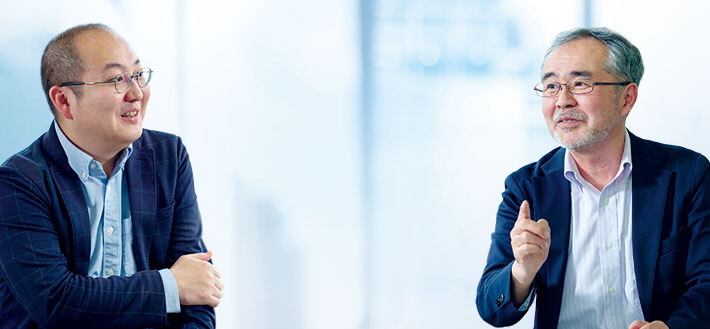
Centering humans within robots and AI
Ishiyama:There are probably some aspects where gently moving actuators and sensors also becomes science through a fusion of various fields. For example, by using deep learning to analyze unstructured data*6 in care-giving obtained with cameras, we can replace some aspects of care through advancements in robotics. I think we will find ourselves in an era when we can achieve well-being through science.
Suzumori:Engineering could be called the history of human development. It seems like this is the era when we moved from tools to energy, and from engineering for survival to engineering for comfort and prosperity.
Ishiyama:That's exactly right. I moved from humanities to science at Tokyo Tech, but my impression was that almost all the humanities people were trying to solve social problems using social sciences, and failing. In contrast, I think there's a lot that can be solved through taking a slightly different, engineering approach. Looking at it from an engineering perspective, I do feel it is an enjoyable field that gives me a huge sense of satisfaction.
Suzumori:I would love for young students to aim for that path if they have the interest. But I think another point is that you need to do the field you're good at. For example, I don't think people should get caught up in popular trends like 3D printing and drones, but only get into them if they are actually good at them and truly want to work on them.
Ishiyama:Certainly in AI as well, you can build a unique position by tackling whatever world you are interested in. In my case, I'm trying to utilize AI in care-giving and transforming working styles. But with the rise of big data and engineering, which haven't yet been very connected with these issues, I believe this field will only expand further in the future. As for you, are there any other things you would like students to keep in mind?
Suzumori:In robotics, if we have even the slightest feeling that something can't be done, that means it absolutely can't be. When I said I wanted to make a robot 20 meters long, there were some students who were with me, and others who said it couldn't be done. Normally, you would assume it is impossible, as it would have to be as big and heavy as a crane. But we actually made a robot that moves using expanding balloons. [Photos 3 and 4] This is the perfect example of an E-kagen robot. We had a basis for achieving it, and I think that sort of faith is important. Personally, I would actually like to set up an "E-kagen Robots Society" someday.
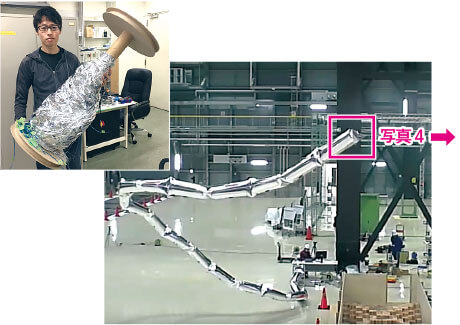
Photo 3. A light, safe robot arm that extents a total of 20 m. Using gravity compensation from helium-filled film-covered balloons as structural materials, the arm's joints move using artificial muscles. The arm folds up to just about 20 cm in size before expanding, and can be easily carried by a single person.
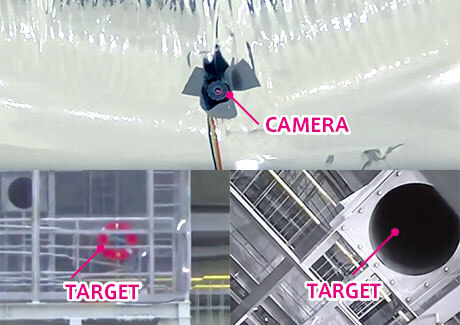
Photo 4. A camera is mounted at the tip of the robot arm. This allows it to freely penetrate tall buildings or towers, imaging its interior to detect abnormalities where humans cannot easily reach. It is expected to find use in initial surveys of disaster sites, building inspections, and the like.
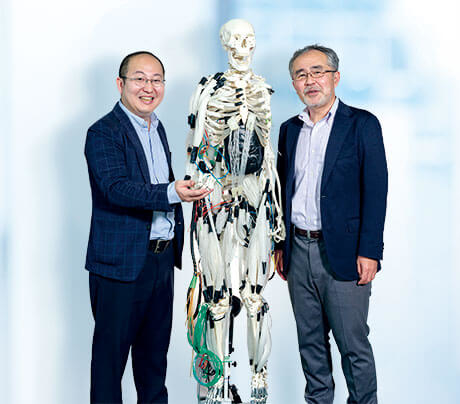
Ishiyama:That sounds like fun. I really hope you do set it up. If you would let me offer some advice as a Tokyo Tech graduate, I think how students' "sensors" are evolving is important. In other words, how they view the social needs of robotics and AI. Science is now entering the era when it will be used to deepen our understanding of the richness and well-being of human society. Globally, we're said to be in Industry 4.0*7, while Japan is giving birth to innovation through its own philosophy, known as Society 5.0*8. As society becomes increasingly mature, the question is whether we can link science and technology with major social issues. I feel that a perspective based on this sort of awareness will become very important for Tokyo Tech students.
Suzumori:As you say, placing humans at the center of robotics and AI will lead to well-being. This is a message I want to pass on to students hoping to join this field or Tokyo Tech.
*1 Agent-based simulation
A method to model the agents that carry out autonomous decision-making as the fundamental units of a system, linking the overall behavior of the system to that of the agents from a bottom-up perspective.
*2 Backpropagation
In machine learning, an algorithm used to make a neural network, which is a mathematical model of the neurons in a human brain, learn.
*3 Soft robotics
A new field of technology that adds the concept of "softness" to robots, which are normally made hard, strong, and precise. The goal is to develop robots that are as flexible as living organisms.
*4 Constraint conditions
In a simulation of the movements of an object, these define whether each degree of freedom is freely mobile, or fixed. For example, when moving just the knee, the hip and ankle are fixed while the knee has a degree of freedom. In other words, a constraint condition is being applied.
*5 Actuators
Refers to driving devices that convert energy to linear or rotational movement using hydraulic or electrical motors.
*6 Unstructured data
Refers to non-structured data that lacks a structural definition in the way normal database models have. This includes images, videos, voice, documents, and so on. Using unstructured data is often referred to as using big data.
*7 Industry 4.0
The "Fourth Industrial Revolution" for manufacturing, a concept first raised in Germany in 2011. An internationally strategic project aimed at creating new business models and values via the digitization of the manufacturing industry.
*8 Society 5.0
One of the core policies for science and technology measures promoted by the Japanese government. Refers to the new society that will create innovation by incorporating new technologies like IoT, robots, AI, and big data into industry and daily life, solving social problems.
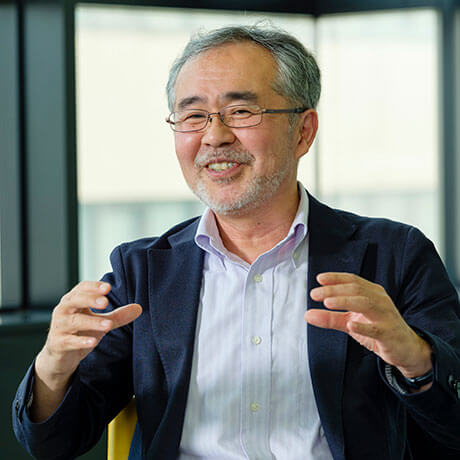
Koichi Suzumori
Professor, School of Engineering, Tokyo Institute of Technology
Obtained his doctorate from the Graduate School of Engineering, Yokohama National University. Joined the Toshiba Research & Development Center (now the Corporate Research & Development Center) in 1984. Joined Micromachine Center in 1999. After serving as a professor at Okayama University from 2001, was appointed professor at Tokyo Institute of Technology in 2014. Founded the venture company s-muscle in 2016 at both Tokyo Tech and Okayama University, starting sales of fine artificial muscles operated with air pressure. Won the Grand Prize in the Prothesis (Robots) section of the 2016 Ghost in the Shell Realize Project with his skeletal robot that uses artificial muscles. Recipient of multiple awards and frequent media appearances in the field of robotics research. Supervising faculty member for the School of Engineering's Department of Mechanical Engineering.
Suzumori/Endo Lab
Aiming to make new robots and mechatronic structures a reality, he carries out a wide range of research from functional device development to system construction and field research. His main research topics include artificial muscles and robot applications, soft robotics, hydraulic tough robotics, physical support robots, and micro-robotics.
Suzumori/Endo Lab

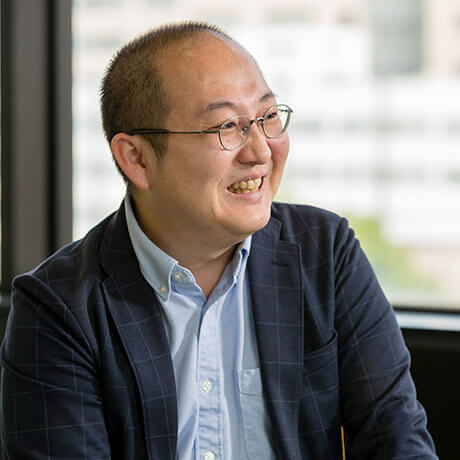
Ko Ishiyama
President and Representative Director, ExaWizards Inc.
Graduated from the Faculty of Commerce at Chuo University in 2004. Obtained his master's degree in 2006 at the Department of Computational Intelligence and Systems Science, Interdisciplinary Graduate School of Science and Engineering, Tokyo Institute of Technology. Joined Recruit Holdings Co., Ltd. the same year. After promoting digitization at Recruit, he founded a new company when he made a proposal under a new business proposal system. After gaining experience guiding the growth of the company before selling it three years later, he was appointed director of Recruit's Media Technology Labs in 2014. In April 2015, he founded the Recruit Institute of Technology, Recruit's AI research institute, and served as its first president. In 2017, he was appointed chief operating officer at Digital Sensation Corporation. Following a merger in October 2017, he was appointed representative director and president of ExaWizards Inc. He is deputy chief of the Strategic Council for AI Technology's Venture Development/Financing Liaison Taskforce under the auspices of the Japanese government. Visiting Professor at Shizuoka University, Visiting Associate Professor at the Policy Alternatives Research Institute, the University of Tokyo.
The Special Topics component of the Tokyo Tech Website shines a spotlight on recent developments in research and education, achievements of its community members, and special events and news from the Institute.
Past features can be viewed in the Special Topics Gallery.
. Any information published on this site will be valid in relation to Science Tokyo.





![A skeletal robot that moves flexibly using artificial muscles. Professor Suzumori explains: "In a normal robot, for example, we would put a shaft in the knee joint, which fixes its center of rotation in place. But in a human, the axis shifts, and we can use these artificial muscles to recreate this shift, giving us 'E-kagen' movement. Also, the artificial muscles are bunched together. So if we have an air leak, we don't replace that muscle. We tie it off and leave it. This is just like how human muscles atrophy [laughs]."](/english/public-relations/img/110-suzumori-lab-03.jpg)









